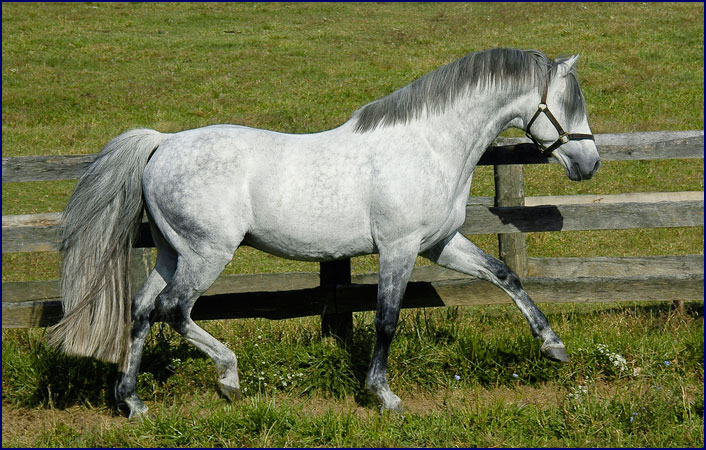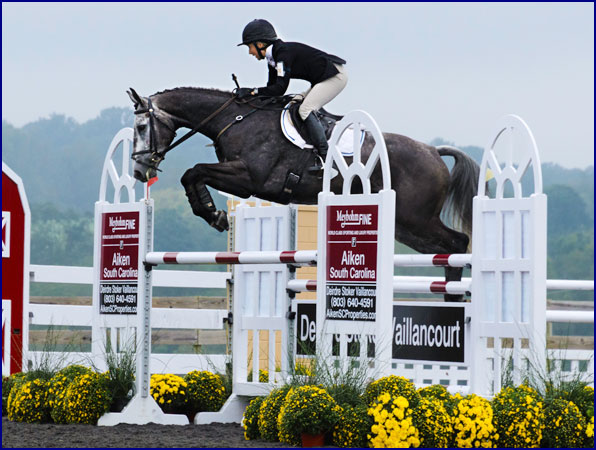|
Please
help us save the traditionally-bred Irish Sport Horse.
The Irish Draught Horse (ID) has been bred for centuries
to run, jump, and go across the countryside. They are
hardy enough to go all day through the toughest foxhunting
country in the world, and gentle enough for a child to
ride. They are valued for their jumping ability,
soundness, and versatility.
The
Thoroughbred (TB) is known for its speed, endurance,
athleticism and heart.
The
Irish Sport Horse (ISH) is a cross between Irish Draughts
and Thoroughbreds, embodying the best of both breeds.
Those that are half TB and half ID tend to be quiet all-rounders
suitable for the amateur to foxhunt and Event at the lower
and mid levels. The ISH that is 3/4 to 7/8 TB is generally
a good prospect for the highest levels of Eventing and
Show Jumping. They tend to be excellent jumpers and lovely
loose movers, with plenty of gallop and stamina. They are
sought after by top Event Riders around the world.
|

Brandenburg's Windstar, half ID and half TB
|
I
recently spent a week in Ireland shopping for young event
prospects, and was shocked to find that the
traditionally-bred Irish Sport Horse is seriously
endangered. Due to the infusion of European warmbloods
into the breeding programs, the ISH breed is being diluted
as more of the ID and ISH mares are being crossed with
warmbloods rather than TBs; therefore fewer and fewer of
the true traditional Irish Sport Horses are being
produced. We are on the verge of losing these valued
bloodlines forever.
It
appears that many breeders and sales yards are choosing
short-term economic gains over heritage, which is very
disheartening. Irish horses take a bit longer to develop
than most other breeds, and it seems that many buyers
don’t understand this. They are attracted to the flashy
movement and jump that many warmbloods show as 2 and 3
year olds, and are choosing these crosses rather than
waiting for the Irish Sport Horses to mature and show
their talent.
As
a result, the Irish breeders, instead of sending their
good ID and ID/TB mares to quality thoroughbred stallions
as in the past, are responding to the market by crossing
their mares with continental warmblood stallions (or ‘foreign
horses’ as the Irish call them), hoping for quicker
sales of their youngstock. These Irish Draught/Warmblood
crosses may show more toe-flicking flash as youngsters,
but they often lack the gallop, stamina and heart needed
for the highest levels of Eventing. The characteristics
that give the warmblood that big trot with the long stride
and slow tempo do not necessarily help him on the
cross-country course or in the hunt field.
If
the sires are approved by the Irish studbook, one can
breed a warmblood mare to a warmblood stallion, and as
long as the foal is born in Ireland it can be fully
registered as an Irish Sport Horse and receive a green
registration book. The average buyer, seeing the horse is
registered, doesn’t know they are not truly getting an
Irish Sport Horse! This might be fine for those producing
Show Jumpers and Dressage horses, but for us Eventers it
is a very negative trend. As fewer and fewer of the
Traditional Irish Sport Horses are bred, the old excellent
bloodlines are going by the wayside, and once they are
gone, they are gone forever.
I
am not knocking the warmblood breeds; they are wonderful
horses. They excel in the Dressage and Jumper worlds, and
there are many who are successful in the Eventing world as
well. Nor am I trying to discourage the breeding of
warmbloods in Ireland, but they should be registered with
their own breed registries rather than as Irish Sport
Horses. I do not go to Ireland to buy warmbloods; I go
there to buy traditionally-bred Irish Sport Horses. I am
terribly afraid that within five years these will be
scarce indeed, and perhaps nonexistent in ten; this will
be a tragic loss to Ireland and horsemen everywhere.
|

Windchase Phoenix Star, 1/4 ID and 3/4 TB
|
The
traditionally-bred Irish Sport Horse, those with ID
bloodlines combined with at least three-quarters TB blood,
excels in the Eventing world - but they are getting harder
and harder to find. On my recent shopping trip, I went to
17 different yards, spread out all over southern and
central Ireland. I looked at a total of 67 horses for
sale, and of those only 12 of them were traditionally
Irish-bred, with only ID and TB blood. The rest were
warmblood crosses. This trend has been going on for a
while, but I was dismayed to see how much it had increased
in the four years since I had last been to Ireland. Only
18.5% of the horses we were shown were truly ‘Irish,’
and that was going to yards of breeders and trainers who
had primarily shown traditional Irish horses in the past.
I
feel it is short-sighted for the Irish Horse Board to
allow the ISH registry to become diluted with other breeds
and to risk losing the old authentic bloodlines. People
from all over the world come to Ireland to shop for Irish
Sport Horses because they have distinctive qualities and
characteristics that no other breed shares. If the ISH
becomes an amalgamation of continental warmbloods and
loses the characteristics that make the breed unique,
Ireland will cease being a leading world marketplace for
horses - buyers looking strictly for warmbloods will be
more likely to go to countries like Germany, France and
Holland.
So
let’s save the Irish Horse! What can we do?
Buyers
- if you are buying an ISH check on his breeding. Talk to
his breeder or look at his registration book and find out
who his ancestors are. Make sure his bloodlines are
compatible with what you want in a horse. Be aware that a
horse can be partially or all warmblood and still
registered as an ISH, and be sure to find out what
percentage of ID and TB blood the horse you are
considering buying has. If there is demand for more
traditionally bred Irish Sport Horses then the breeders
will produce them. When searching for horses, let the
breeders and dealers know that you are interested in the
classic bloodlines and the traditional Irish horse.
Riders
and Trainers – recognize that the ISH matures slowly and
give them the time to develop properly. Train them
carefully and correctly, don’t take shortcuts, and give
them every chance to reach their top potential.
Irish Horse Board and Irish Draught Horse Society –
consider a separate registry for the warmbloods and
warmblood crosses, rather than letting them be registered
as Irish Sport Horses. Create financial incentives for
breeders to produce traditionally-bred Irish horses.
Breeders
- preserve those bloodlines! Keep producing those
traditional Irish Sport Horses with a combination of ID
and TB blood. Breeding often does not offer much in the
way of financial gain, but then that’s not what you got
into it for in the first place, is it? The satisfaction of
producing a quality horse is its own reward, and knowing
you are helping to protect the breed will make it all the
more worthwhile. Let’s be sure that we have traditional
Irish horses to ride and enjoy for the future.
Cheers,
Phyllis
|